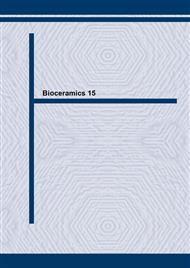[1]
G. Berger, R. Gildenhaar, and U. Ploska (1995) Biomaterials 16: 1241-48.
Google Scholar
[2]
G. Berger, R. Gildenhaar, and U. Ploska (1995) in Bioceramics, Vol. 8 (eds. L.L. Hench and D. Greenspan) Pergamon/Elsevier Sci. Ltd., pp.453-56.
Google Scholar
[3]
M. Schneider, R. Gildenhaar, and G. Berger (1994) Cryst. Res. Techn. 5: 671-75.
Google Scholar
[4]
G. Berger, R. Gildenhaar, U. Ploska, and M. Willfahrt (1997) in Bioceramics Vol. 10 (eds. L. Sedel and C. Rey) Elsevier Science Ltd., pp.367-70.
DOI: 10.1016/b978-008042692-1/50087-x
Google Scholar
[5]
K.-W. Harbich, M.P. Hentschel, J. Schors (2001) NDT&E International 34: 297-302. Acknowledgements The authors would like to thank Mrs. Heidi Marx (BAM, V.4901) and Theodor Moelders (BAM, V.11) for sample preparation and Dr. Gert Nolze (BAM, V.11) for making the SEM investigations. Figure 3. Powder particles (left hand site) that were not involved in the sinter process Fig. 4: Scanning electron micrograph showing a part of the spongiosa-like rapid resorbable ceramic scaffold. The ceramic material is intersected by microcracks causing high specific internal surface properties as detected quantitatively by Xray refraction
Google Scholar


